Code of practice for stop and search in Scotland: six-month review
Report on behalf of the Independent Advisory Group on Stop and Search presenting the findings of the interim six month review.
2 Changes following implementation of the Code
2.1 Change in police use of search and seizure
During the first full six month period following the introduction of the new Code of Practice ( CoP) on Stop and Search (June to November 2017), there were 17,446 encounters involving either a search or a seizure in Scotland. This compares to 24,210 during the equivalent six month period of the previous year and represents a reduction of 28% in the use of these police tactics. The number of searches and seizures did not drop as a direct consequence of the introduction of the Code of Practice on 11 th May 2017; rather, this reduction reflects an ongoing steady decline which can be traced back to the critical HMICS report published in March 2015. Figure 1 shows the decline in recorded searches and seizures between May 2016 and November 2017, during which time the number of encounters reduced by 51%. The number of searches and seizures during each of the six months following the introduction of the CoP (highlighted in Figure 1) is clearly smaller in comparison to the equivalent six months of the previous year; however, the actual trend is very similar, with higher numbers in the summer months and fewer in the autumn months, which is indicative of an overall decline in numbers but a consistent seasonal pattern.
Figure 1: Number of searches and seizures carried out in Scotland since April 2016 ( COP 6 month review period highlighted)
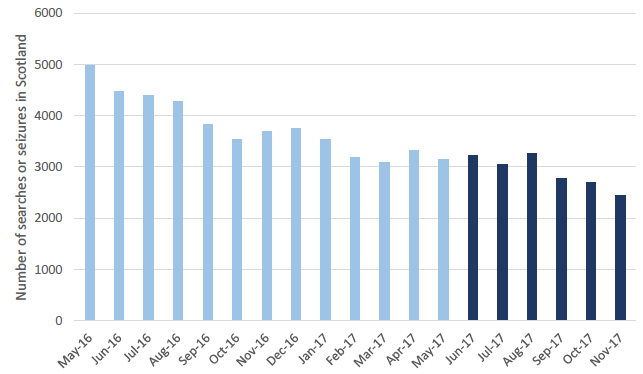
There was a distinct difference in the breakdown of searches and seizures following implementation of the CoP. Table 1 shows the breakdown of policing encounters by number and percentage in the six months after the CoP came into force compared with the equivalent six months of the previous year. It reveals that seizures reduced as a proportion of all encounters from 18% to 10%. As the analysis compares the same time period in each year, this difference is not accounted for by seasonal difference and instead suggests that police use of seizure has reduced at a disproportionately greater rate than the use of stop and search. This is confirmed by the indexed trends in Figure 2 which show that the percentage change in number of seizures declined far more than that for searches during the year prior to the introduction of the CoP and, despite an initial increase in seizures immediately prior to the CoP introduction, they continued to decline more steeply afterwards. Indeed, the number of seizures declined by 89% over this period compared with only a 40% drop in the number of searches. This trend will be commented on further in section 3 in relation to the use of search and seizure as a policing tactic for dealing with underage drinking; however, it is clear from these data that the police use of search and seizure changed both before and after implementation of the CoP but it did not change consistently for both tactics.
Table 1: Number of police searches and seizures pre and post-implementation of the Code of Practice (% of all searches/seizures)
| June to November 2016 | June to November 2017 | % Change in relative share | |
|---|---|---|---|
| Statutory searches | 19,257 (80%) | 15,724 (90%) | +10% |
| Consensual searches | 616 (3%) | 0 (0%) | -3% |
| Seizures | 4337 (18%) | 1722 (10%) | -8% |
Note: Column percentages may not total 100% due to rounding.
Figure 2: Percentage change in police use of search and seizure since May 2016
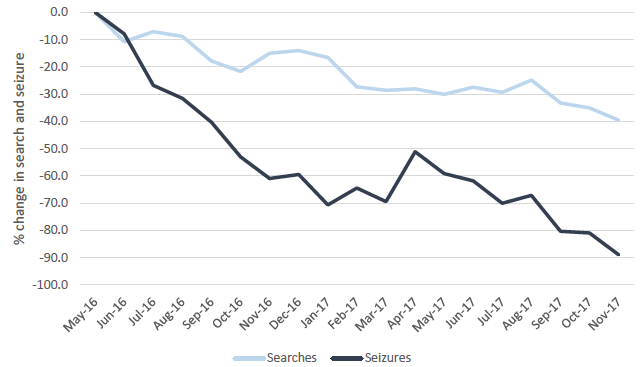
2.2 Change in positive detection rate for stop and search
Despite the decline in the overall number of searches, the success rate in terms of positive detection increased. Table 2 shows that the percentage of positive searches following implementation of the CoP was 37%, a statistically significant increase of 7% compared to the equivalent six month period the year before. What is more, the positive search rate had increased (to varying levels) regardless of the type of search carried out. For example, the percentage of positive searches increased by 6% for drugs, 10% for stolen property and 12% for fireworks (although these were very small in number). The rate of positive searches for offensive weapons also increased by 7%, although this remained far lower than average at only 25%. It is worth noting that a new category for recording searches of people carried out in accordance with a warrant was added to the Police Scotland database following the introduction of the CoP, and these had a higher than average positive rate.
Table 2: Number of positive police searches pre and post-implementation of the CoP (% of all searches)
| June to November 2016 | June to November 2017 | % change in positive rate |
|
|---|---|---|---|
| All searches | 5,876 (30%) | 5,778 (37%) | +7% |
| Searches by type: | |||
| Drugs | 5205 (31%) | 4,785 (37%) | +6% |
| Stolen property | 404 (31%) | 526 (41%) | +10% |
| Offensive weapons | 188 (18%) | 200 (25%) | +7% |
| Fireworks | 11 (11%) | 13 (23%) | +12% |
| Warrant | - | 207 (41%) | - |
| Other reason | 68 (25%) | 47 (30%) | +5% |
2.3 Geographical change in the use of search and seizure
Command Area
Prior research (Murray 2014; McVie and Murray, 2017) demonstrated that the use of search and seizure in Scotland varied significantly by geographic area. Police Scotland is divided into three large Command Areas: East, North and West. Prior to the implementation of the CoP, the majority of searches and seizures were carried out by officers in the West Command Area. Even taking account of differences in population size, there was disproportionate use of these tactics in the legacy Strathclyde police force area. Following implementation of the CoP, the number of searches and seizures in the West Command Area fell by almost 50% and, more importantly, the relative share of all searches and seizures declined from 71% to 51% when comparing the two equivalent time periods, as shown in Table 3. Despite the very large reduction in searches and seizures at a national level, the numbers in the East and North Command Areas both increased in the period following implementation of the CoP, as did their relative share of all encounters.
Table 3: Number of searches and seizures pre and post-implementation of the CoP by Command Area and Division (% of all searches)
| Command Area | June to November 2016 | June to November 2017 | % change in relative share |
|---|---|---|---|
| East | 2,648 (11%) | 3,806 (22%) | +11% |
| North | 4,358 (18%) | 4,778 (27%) | +9% |
| West | 17,204 (71%) | 8,862 (51%) | -20% |
Note: Column percentages may not total 100% due to rounding.
Analysing the total number of searches and seizures in each Command Area makes an assumption that the level of demand for policing is likely to be similar in each area; however, this is unlikely to be the case. There are many factors that can impact on the level of demand for policing, but one of the most common factors is the population size which is different in each area. In order to compare Command Areas on a like-for-like basis, the level of search and seizure was calculated as a rate per capita. Figure 3 shows the difference between the search rates in each Command Area in the six months following the introduction of the CoP and the equivalent period of the previous year. Prior to the introduction of the CoP, the West Command area had a far greater rate of search and seizure, at 6.9 per 1,000 of the population, than the North, which had a rate of 3.3 per 1,000, which in turn was greater than the rate of search and seizure in the East of Scotland, at 1.5 per 1,000. In the six month period after the CoP came into being, however, the rate of search and seizure in the West Command Area fell to 3.7 per 1,000 population which was almost identical to the rate in the North, at 3.6 per 1.000. Rates in the East Command Area increased, but remained lower than the other two Areas at 2.3 per 1,000 people.
Figure 3: Rate of search and seizure per capita by Command Area, pre- and post- CoP

Comparison of the two time periods in Table 3 and Figure 3 suggest that there were significant changes in policing practice as a result of the CoP coming into practice, and that these changes were not consistent across the country. However, analysis of the trends month by month provides a clearer picture of the changing geographical pattern. In the West Command Area, there was a fairly steady decline month on month in the number of searches and seizures, which started well before the implementation of the CoP and continued after it. Indeed, over the period between May 2016 and November 2017, searches and seizures in the West declined by 69%. Meanwhile, the number of searches and seizures in the North and East Command Areas fluctuated month to month but showed no significant upward or downward trend over time.
The increase in numbers between the two time periods shown in Table 3 actually appears to be due to an unusually low number of searches and seizures in the North and East during the June to November 2016 period rather than a significant increase following implementation of the CoP. There is anecdotal evidence of a decline in the use of search and seizure within some areas of Scotland immediately prior to the start of the Police Scotland training programme (and, possibly, in anticipation of the introduction of the CoP), which is consistent with this pattern of activity. Figure 4 clearly shows that the most significant change to practice occurred in the West Command Area and that this reflected a very large and sustained decline in the use of these tactics.
Again, however, analysis of the raw numbers tells only a partial story. If we calculate the rate per capita of search in each of the three Command Areas using population size, we see a slightly different picture. Figure 5 shows that the rate of search in the West Command Area fell from around 14.5 per 10,000 in May 2016 to 4.6 per 10,000 in November 2017, which was actually lower than the rate of search in the North by this final month. These figures suggest that policing practice in the West of Scotland has become far more similar to that in the North of Scotland, when taking account of population size. The rate of search and seizure in the East of Scotland has remained consistently lower than the other two areas of Scotland, however.
Figure 4: Change in the number of searches and seizures by Command Area since May 2016
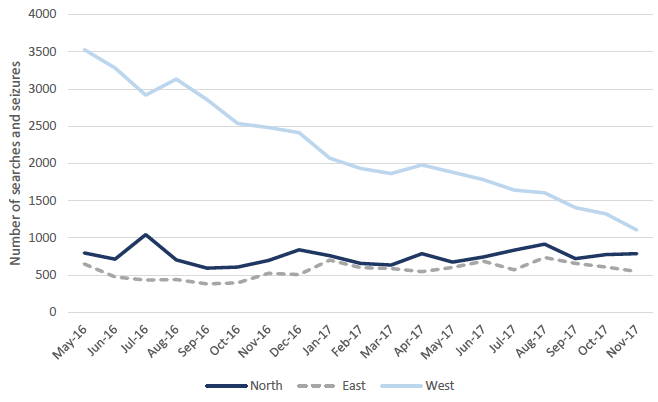
Figure 5: Change in the rate of search and seizure per capita by Command Area since May 2016
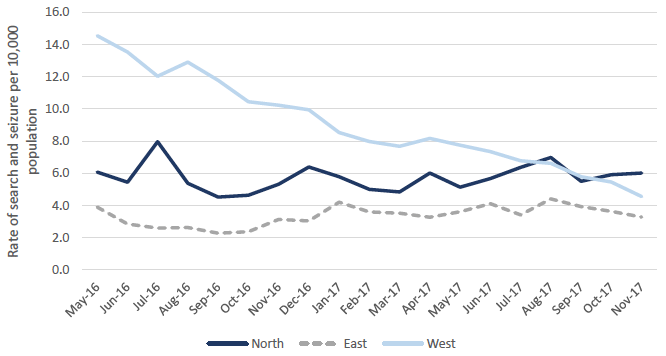
Division
Within the three Command Areas there are a total of 13 Police Scotland Divisions. Looking at the change in use of search and seizure by Division, Table 4 shows that Greater Glasgow Division accounted for the largest share of all encounters in Scotland both before and after implementation of the CoP. Nevertheless, there was a 63% decline in the number of searches and seizures in Greater Glasgow during the six months following the introduction of the CoP as compared to the equivalent six month period in the previous year. This resulted in a 22% decrease in the percentage share of all searches and seizures that were attributed to Greater Glasgow. There were also large declines in the number of encounters in the other West Divisions, with the exception of Dumfries and Galloway which saw a 78% increase in the use of searches and seizures (although due to small numbers this represented only a 2% increase in the relative share of searches and seizures). There was very little change in the percentage share of encounters for the other West Divisions, however, which suggests that they all declined more or less in line with the average rate of change.
In all of the East and North Divisions, the number of searches and seizures was higher in the period following implementation of the CoP compared to the equivalent period of the previous year. Correspondingly, the percentage share for each of these Divisions increased, with the largest increases occurring in the North East of Scotland and in the City of Edinburgh.
Table 4: Number of searches and seizures pre and post-implementation of the CoP by Division (% of all searches)
| Police Division | June to Nov 2016 N (%) | June to Nov 2017 N (%) | % change in relative share |
|---|---|---|---|
| West Command Area: | |||
| Greater Glasgow (G) | 11,194 (46%) | 4,105 (24%) | -22% |
| Renfrewshire & Inverclyde (K) | 1,718 (7%) | 1,141 (7%) | 0% |
| Argyll & West Dunbartonshire (L) | 897 (4%) | 757 (4%) | 0% |
| Lanarkshire (Q) | 1,865 (8%) | 1,185 (7%) | -1% |
| Ayrshire (U) | 1,115 (5%) | 934 (5%) | 0% |
| Dumfries & Galloway (V) | 415 (2%) | 740 (4%) | +2% |
| North Command Area: | |||
| North East (A) | 1,791 (7%) | 2,256 (13%) | +6% |
| Tayside (D) | 1,253 (5%) | 1,176 (7%) | +2% |
| Highlands & Islands (N) | 1,314 (5%) | 1,346 (8%) | +3% |
| East Command Area: | |||
| Edinburgh (E) | 814 (3%) | 1,291 (7%) | +4% |
| Forth Valley (C) | 626 (3%) | 770 (4%) | +1% |
| Lothians & Borders (J) | 641 (3%) | 1,068 (6%) | +3% |
| Fife (P) | 567 (2%) | 677 (4%) | +2% |
Note: Column percentages may not total 100% due to rounding.
Looking in more detail at change in the number of searches and seizures by Division on a month by month basis, there is some evidence of geographical variation in shifting police practice as a result of the implementation of the CoP. In three Divisions, the number of searches and seizures increased in the six month period after the CoP was introduced and remained at a level that was higher than previously. Figure 6 shows that in the months following introduction of the CoP (represented by the dotted vertical line), there was a large percentage increase in encounters in the Lothians and Borders and in Dumfries and Galloway which was distinctly different to the trend in the prior year. In the North East Division, there was a much smaller increase in searches after the CoP which then plateaued, but it remained at a level that was higher than before the CoP came into force. It is worth noting that these indexed trends are based on relatively small numbers (especially those for Lothians and Borders and Dumfries and Galloway); however, the change does seem to have been precipitated in the month or so immediately prior to the implementation of the CoP and to have been sustained in the period afterwards.
Figure 6: Increase in search and seizure following implementation of the CoP, by Division
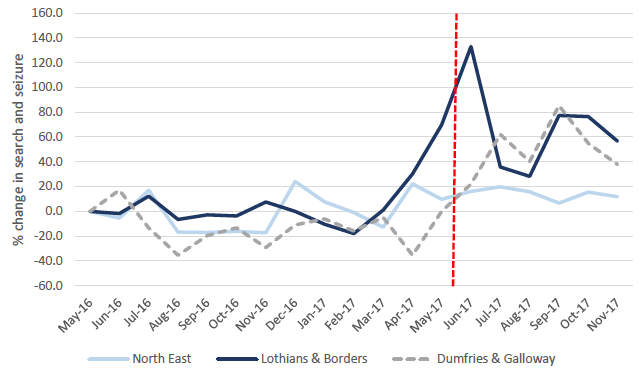
Showing a slightly different pattern, Figure 7 shows that in Edinburgh and the Highlands and Islands there were large spikes in activity in August 2017. These spikes coincided with large annual events at which increased levels of policing would be expected, namely the Edinburgh International Festival and the Groove Loch Ness concert in Inverness. Similar but much smaller spikes were also evident in August 2016 during the time of these events. There are a number of possible explanations for the spikes being smaller in the previous year. For example, there may have been a lower level of threat or demand; police manpower during 2016 may have been reduced; levels of recording may have been lower in the previous year; or there could have been an increase in confidence in the use of search and seizure following the Police Scotland training and the implementation of the CoP. All of these theories would benefit from further consideration in the 12 month review.
Figure 7: Distinctive spikes in search and seizure following implementation of the CoP, by Division
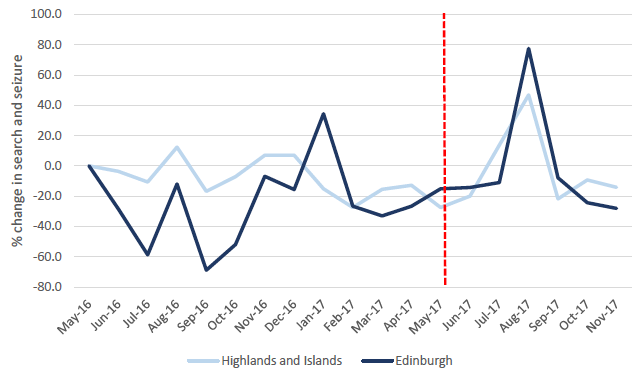
Four Divisions – all from the West of Scotland - displayed an ongoing decline in the number of search and seizures, which started well before the implementation of the CoP and continued after it. Figure 8 shows that the numbers of searches in Greater Glasgow, Renfrewshire & Inverclyde, Ayrshire and Lanarkshire all declined during 2016. Greater Glasgow shows a less steep but more continuous decrease over the period from August 2016 to November 2017 compared to the others. In contrast, Ayrshire, Lanarkshire and Renfrewshire & Inverclyde displayed a far steeper initial decline from May/June 2016, followed by an increase around the beginning of 2017 (which coincides with the Police Scotland training on stop and search). This increase continued for these three Divisions until May/June 2017, which was around the time of the introduction of the CoP. However, all three Divisions saw a further significant reduction in searches and seizures during the six months following the implementation of the CoP.
In the remaining four Divisions (Tayside, Fife, Forth Valley and Argyll & West Dunbartonshire), the trend in searches and seizures remained relatively stable following implementation of the CoP, although all four had shown a decline in numbers during 2016. It seems likely, therefore, that the introduction of the CoP made little difference to policing practice in these Divisions and that any changes as a direct result of the new legislation had already been set in motion well before the actual implementation period.
In those Divisions (shown in Figures 6 and 7) where there was evidence of an increase in the use of search and seizure (whether constant or for specific events) it is possible that this is indicative of an increasing enthusiasm and confidence amongst police officers to use such encounters as determined by the new regulatory framework and supported by the Police Scotland training. Whereas, in those Divisions (shown in Figure 8) that showed a decline in search and seizure following the implementation of the CoP there may be issues around the understanding of the legislation or reduced confidence around using the tactic. Whatever the case, it will require qualitative research to determine the reasons for these geographical differences and it is recommended that this should form part of the 12 month review.
Figure 8: Ongoing decline in search and seizure pre- and post- CoP, by Division
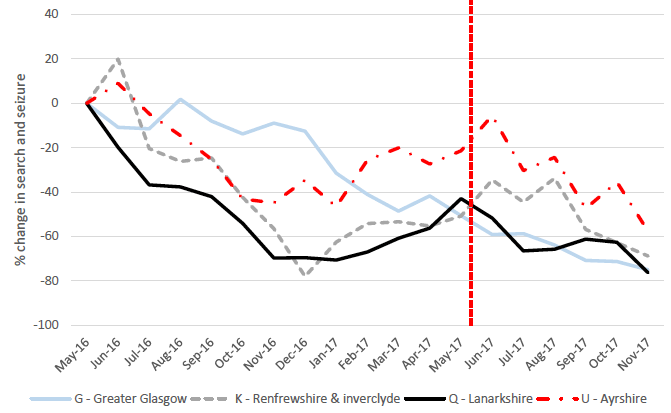
Change in positive detection by Division
Section 2.2 noted that the overall reduction in the number of police searches in the period following the implementation of the CoP coincided with an increase in the positive detection rate (regardless of the reason for the search) compared to the equivalent six month period of the previous year. Given that there was such a large degree of change and variation in use of search at a Divisional level, it is helpful to examine whether these changes improved the use of reasonable suspicion and, therefore, increased the likelihood of success. Figure 9 shows the percentage of searches which resulted in a positive outcome for each Division, and for Police Scotland as a whole, in the pre- and post- CoP periods. It is clear that there was wide variation in successful outcomes across Divisions both before and after the CoP was introduced. Some Divisions showed little or no change in positive outcome between the two periods; for example, Ayrshire, Lanarkshire, Lothian & Borders, Argyll & West Dunbartonshire, Dumfries & Galloway and the North East Divisions saw very minor changes in outcome. Others had experienced a large increase in positive search outcomes; such as Fife, Renfrewshire & Inverclyde, Highlands and Islands, Greater Glasgow and Edinburgh. While two Divisions, Tayside and Forth Valley, saw a decline in the positive search rate.
There is no clear relationship between the change in positive search rates and the trends in the number of searches carried out. For example, the Divisions which showed no change in outcome included Ayrshire and Lanarkshire, both of which had a sustained decrease in search following the introduction of the CoP, and the North East, Lothian & Borders and Dumfries & Galloway Divisions which had an increase in searches over the same period. Similarly, those Divisions which had a significant increase in positive search outcomes included Greater Glasgow and Renfrewshire & Inverclyde, which both saw a sustained reduction in searches following the introduction of the CoP, and Edinburgh and the Highlands & Islands which saw little change in search rates other than distinct spikes coinciding with major events during the same period. It is clear, therefore, that whatever influenced the pattern of stability or change in the rate of positive outcomes for searches across different parts of Scotland cannot simply be explained by trends in the number of searches. Again, this is an issue that would benefit from further examination in the course of the 12 month review.
Figure 9: Percentage of positive police searches pre- and post- CoP, by Division

2.4 New information on stop and search
Strip and intimate searches
Since the introduction of the CoP, some new information has become available about search and seizure on the NSSU Stop and Search Database. This includes information about the use of strip searches and intimate searches, both of which were covered by Annex C of the new CoP. According to Annex C: “A strip search is a search involving the removal of more than outer coat, jacket, gloves, headgear or footwear”. It is permitted only in circumstances where the officer has reasonable suspicion that a person has concealed an article (such as drugs or a weapon) under their clothing, and it should be conducted in a relatively private place so that the person detained cannot be seen by others. Annex C further states: “An intimate search consists of the physical examination of a detainee’s body orifices other than the mouth”. Intimate searches are clearly much more intrusive they can be conducted only on issue of a warrant by a Sheriff and must be carried out by an authorised health care professional. The use of strip and intimate searches was not recorded or reported prior to the introduction of the CoP.
In the six months following the introduction of the CoP, there were a total of 786 strip searches across Scotland (an average of 131 per month). Of these, 69% were conducted inside a police station and 31% were conducted out of public view somewhere other than a police station. Almost half (47%) of all strip searches resulted in an item being found. The majority of strip searches involved a person aged 18 or over, with only 4% (33 in total) involving young people under the age of 18. The positive search rate for strip searches of young people (48%) was not significantly different to that for adults. There were no intimate searches conducted during this six month period. While there are no specific issues that require to be examined in relation to strip searches in the 12 month review, it is recommended that these be monitored over time through any new reporting arrangements established by Police Scotland and the SPA.
Issue of receipts
Data is also available from the NSSU database on the issue of receipts by police officers following a search. In section 6 of the CoP, it is stipulated that:
“The person who has been searched should be given a receipt (see Note 12). The receipt should include the following information:-
- police powers of stop and search;
- the right of a person searched to obtain a copy of the record of the search;
- the right of a person searched to complain, including how to go about making a complaint”.
While officers are obliged to offer a receipt following a search, which includes placing it with the detainee’s property in the event that the individual is taken into custody, the individual may refuse to accept the receipt. In these circumstances, the advice offered during stop and search training is that the officer should record in their notebook that the receipt has been offered and refused. The CoP also makes it clear that where the officer conducting the search is called to an urgent incident, it may be impracticable to provide a receipt. In this event, the individual should be informed that they can obtain a copy of their search record by calling at any police station (although, only if they have provided their details). Receipts are not issued for seizures.
In the six months following the introduction of the CoP, 13,619 receipts were issued following a search. This represents 87% of all statutory searches conducted during this period. In the remaining 2,105 cases (13%), no receipt was issued. There was no evidence that this varied by month (i.e. no indication that the issuing of receipts was lower immediately following the introduction of the CoP and gradually increased over time, which may have suggested a ‘bedding in’ period). In addition, the issuing of receipts did not vary significantly by day of the week (i.e. it was not lower on days when there was a higher volume of searches); or by the reason for the search; or by whether or not the search resulted in a positive outcome; or according to the ethnicity of the person being searched.
There were a number of factors that were associated with whether or not a receipt was issued. For example, the likelihood of a receipt being issued varied according to the time of day that the search was carried out; unexpectedly however, receipts were less likely to be issued during times of the day when there was a lower volume of search (from midnight to midday) than at busier times of the day (from midday to midnight). In addition, receipts were slightly more likely to be issued to children and young people up to the age of 25 than to people in older age groups; and more likely to be issued to women than men.
The biggest difference, however, was geographical. Searches in the East of Scotland were significantly more likely (93%) to result in a receipt being issued compared to those in the North (86%) or West (85%). This is evident when looking at the percentage by police Division, in Figure 6, which shows that three of the four East Divisions were the most likely to issue a receipt. Looking at those Divisions with the lowest issue rate, population size may have some bearing on this pattern, given that the Lanarkshire, North East, Greater Glasgow and Edinburgh Divisions have the largest population sizes in Scotland.
Figure 6: Percentage of searches resulting in a receipt being issued by police Division, post- CoP
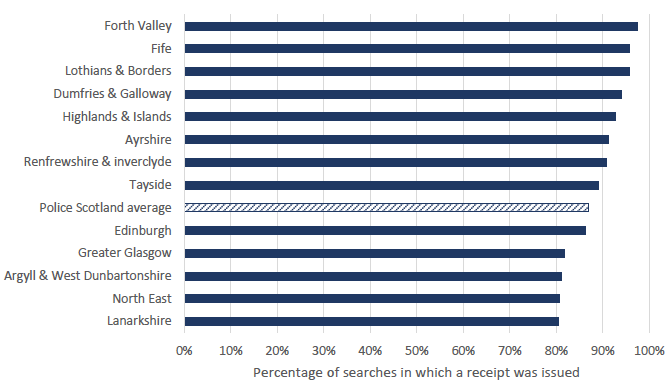
It was not possible to investigate this further, since there is no information contained in the Stop and Search Database on the number of receipts that were refused, the number that were not issued due to circumstances in which the officer was called to an urgent incident, or the non-issue of receipts for some other reason. It would be fruitful to include some analysis of this trend in the interviews conducted with police officers as part of the 12 month review.
It is expected that officers explain to any person being searched that they are entitled to obtain a copy of the record of the encounter within 6 months of the date of the search, although this only applies if the individual has chosen to give their name, address and date of birth, which they are not obliged to do if the search is negative. Data on the number of people who choose to obtain a copy of their record are not published on the Stop and Search Database. However, data provided by Police Scotland reveal that there were only five requests for a copy of the search record during the six months after the introduction of the CoP. Of these, one was submitted by a solicitor and four were made by the person searched. They were made across a range of dates and from different police Divisions, and the age spread of those making the request was from 27 to 71. There were no requests by young people under the age of 18.
2.5 Summary
Overall, there is no compelling evidence that the introduction of the CoP on police use of stop and search had a dramatic impact on policing at the time of its implementation in May 2017 or in the six months afterwards. Instead, the high level of criticism targeted at the over-use of searching practices in Scotland in the preceding two years, followed by an intense period of scrutiny and the decision to abolish consensual searching and introduce a CoP, undoubtedly all played a part in driving down the number of encounters well before the CoP finally came into force.
It is notable that the decline in the number of searches has coincided with an increase in the relative productivity of search encounters, which provides some evidence that they are being used more effectively and this is to be welcomed. Nevertheless, the data suggests there was a greater proportionate decline in seizures than searches during the last 18 months which was not expected, especially given the concerns expressed by policing representatives and other organisations in the public consultation period about the lack of a legal power to search for alcohol. In addition, the data presented in this report continues to demonstrate the enormous geographical variation in the use of search and seizure. At a general level, these findings highlight a very high proportionate decline in searches and seizures in the West of Scotland compared to the North (which remained fairly stable) and the East (which slightly increased). Within specific Divisions, however, the story is much more complex and it is clear that the introduction of the CoP has had a differential impact on policing practice and positive outcomes across different parts of Scotland.
New information provided on the Stop and Search Database about strip searches revealed that there is an average of 131 per month, of which only 4% involve young people under the age of 18. These have a higher detection rate than average, at 47%, which suggests that a higher threshold of reasonable suspicion is used when deciding to conduct a strip search. No intimate searches were recorded in Scotland since the introduction of the CoP. New information on the issue of receipts following a search shows that receipts were issued after 87% of recorded searches, although this proportion varied according to a range of factors, including geography. Certain divisions had far higher issue rates than others, which may be related to population size and level of police demand; however, this would benefit from further examination.
Recommendations for the 12 month review:
1. To examine the reasons for the geographical differences in the changing patterns of search and seizure based on police Division.
2. To examine the reasons for the geographical differences in rates of positive search based on police Division.
3. To examine the reasons for the non-issue of receipts to people who have been subject to search and to consider the geographical differences in issuing receipts between police Divisions.
Contact
There is a problem
Thanks for your feedback